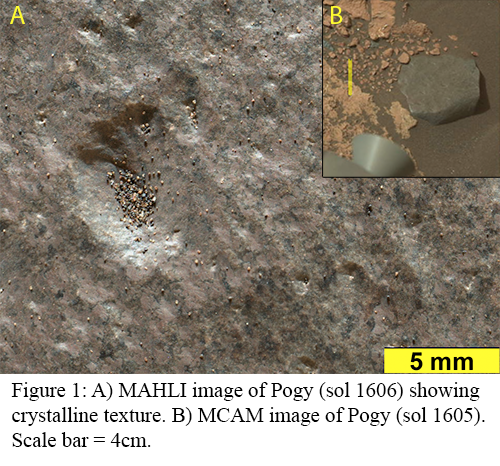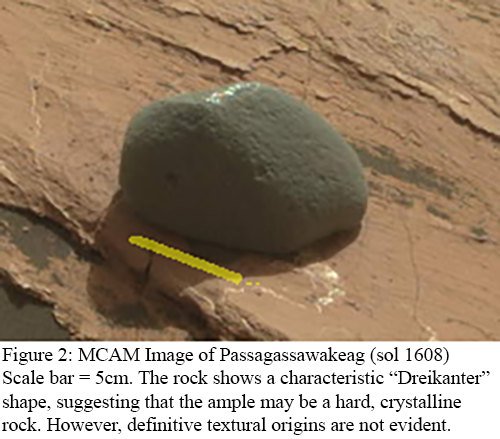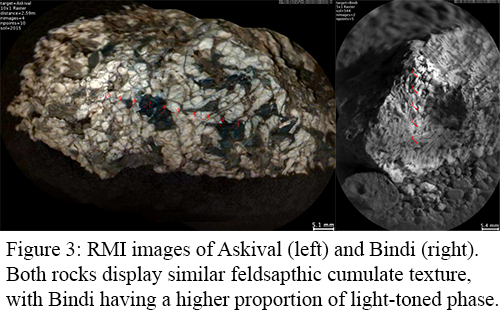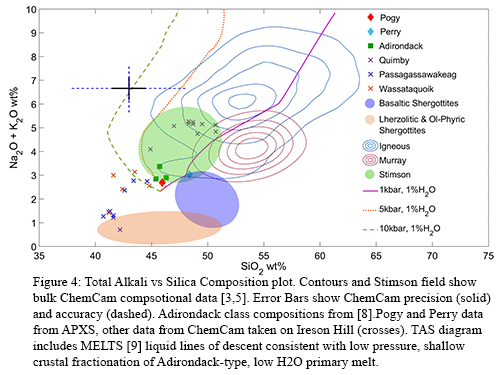Igneous Float Rocks at the Ireson Hill and Bressay Localities, Gale Crater, Mars
- 1University of Leicester, Physics and Astronomy, United Kingdom of Great Britain and Northern Ireland (dlb28@le.ac.uk)
- 2IRAP-OMP, CNRS-UPS, Toulouse, France
- 3AstrobiologyOU, The Open University, UK
- 4Los Alamos National Laboratory, Los Alamos, NM, US
- 5Planetary and Space Science Centre, University of New Brunswick, Canada
- 6Lunar and Planetary Institute USRA, TX, USA
- 7Johnson Space Center, TX, USA
- 8Planetary Science Institute, Tucson, AZ, USA
Introduction: Igneous compositions found in float rock within Gale crater have revealed previously unseen compositional diversity, with a range of chemistry that predominantly falls into basaltic and trachy-basaltic classification [1]. In addition, Gale sedimentary rocks, both float and in situ, record a combination of source compositions and diagenetic overprints [2,3]. We examine several float samples identified by the Mars Science Laboratory mission’s Curiosity rover at different sites: 1 target from the approach traverse to the Kimberley site (sol 544); 4 targets from Ireson Hill (circa. sol 1600); 1 target from the Bressay site (sol 2018), to investigate their origin and relationship to previous units as well as wider Martian igneous chemistry. We use data from the ChemCam LIBS, APXS, Mastcam (MCAM), Mars Hand Lens Imager (MAHLI) and ChemCam Remote Micro-Imager (RMI) cameras. These targets were selected on the basis of distinctive chemical compositions and textures, falling outside typical igneous Gale float classification [2]. We employ the MELTS software package [4] to investigate possible magmatic sources and evolution pathways for these samples.

Float Rock Textures: Among the Ireson Hill samples, Pogy shows an unusual texture with two visually distinct phases (Fig. 1). A lighter toned phase makes up ~50% of Pogy’s texture, and the darker toned phase ~10% (measured through pixel counting of manually selected areas), with the remainder being interstitial material without distinct grains. Both phases are anhedral, with grain sizes typically ranging from 1-1.5 mm. The texture appears largely crystalline. It appears notably dissimilar in appearance to the local Stimson in situ and float rocks [5] found at Ireson Hill.

Among the other Ireson Hill targets, Passagassawakeag is an instance of a well-defined Dreikanter, which hints at a harder, crystalline mineralogy (Fig. 2). The remaining targets, Quimby and Wassataquoik do not show such strong evidence for igneous origin in available RMI and Mastcam imagery, but also do not feature the sedimentary texture of surrounding bedrock and float targets, and we therefore include them as possible igneous targets in this analysis.
The two remaining targets discussed here, Bindi and Askival, display similar textures to each other. Both rocks display cumulate texture (Fig. 3), with light-toned, subhedral mineral grains with sizes up to >10 mm accounting for the majority (65%-70% in Askival) of the texture and dark toned assemblages (30%-35% in Askival) poikilitically enclosing the light toned grains, as interstitial material. Examples of small dark crystals enclosed within the lighter phase are also present. Askival also displays limited (approx. 1.2%) light toned sulphate emplaced as interstitial material. When combined with chemical analysis (below) of the light-toned grains this identifies these samples as feldspathic cumulates.

Compositions: Results for Pogy are presented SO3-free with a corresponding amount of CaO removed in order to account for excess CaSO4 present on Martian rock surfaces. Results were then recalculated to 100% total weight. Pogy’s APXS geochemical composition (Fig. 4) shows similarity in SiO2, Na2O, K2O, CaO, Al2O3 & TiO2 to the Adirondack-class basalt compositions predominant at the Gusev crater MER mission site, although it has a lower Mg#. However, we note that this similarity does not in itself establish an igneous origin for Pogy as Martian sedimentary rocks can also record igneous source compositions [1,3,5,7].

MELTS [4] modelling (Fig. 4) indicates that Pogy-like compositions can be generated by fractionation of magmatic compositions previously derived as parental to Adirondack-class basalts [9], with approximately 13% of the original mass removed through olivine fractionation. The exact conditions of magmatic evolution differ somewhat from the Gusev basalt pathways in order to account for the lower Mg# of Pogy’s composition compared to the Adirondack composition.
Bindi and Askival display clearly feldspathic compositions for a subset of the ChemCam LIBS spots, where the targeted spot was on a light-toned grain. Dark toned grains have mafic compositions. The two targets overall chemistry is differentiated by a higher SiO2 abundance in Askival. Comparing other elemental oxide abundances to SiO2 (Fig. 5 reveals a trend away from the Bindi compositional area, which we interpret as evidence of post-cumulate formation silicification. Comparison of the Albite-Anorthite phase ratio (Fig. 6) between Askival and Bindi shows an overlap, indicating that the cumulates may have formed under similar conditions. We again use MELTS with a variety of input compositions. Modelling performed with the “Johnnie” (basaltic Gale crater target) composition (Fig. 6) produces feldspars with similar phase compositions to those seen in Askival and Bindi.
Conclusions: Ireson Hill float rocks show a variety of textures and compositions, some of which e.g. Passagassawakeag and Pogy appear to be more crystalline than local Stimson bedrock and derived float. Pogy appers to be an igneous, plutonic rock, with an uncertain emplacement process at Ireson Hill.
Comparing to known Gale compositions and rocks, suggests that the Pogy composition represents low pressure, low H2O, fractionation in a shallow crustal setting. This has been preserved either directly as an igneous rock or as a dominant source component in some Gale sedimentary units [5]. The Askival and Bindi float targets are feldspathic cumulates, with Askival’s composition showing evidence for alteration of an original state similar to Bindi. MELTS modelling indicates that these cumulates could have been derived from a source with similar composition to typical Gale crater basalts.
References: [1] Edwards, P.H., et al.,. MAPS, 2017. 52(11): p.2931-2410. [2] Cousin, A., et al. Icarus, 2017. 288: p.265-283. 113622 [3] Bedford, C.C., et al.,. GCA, 2019. 246: p.234-266. [4] Ghiorso, M.S. et al. Eos, Trans AGU, 1994. 75(49): p.571-576. [5] Bedford, C.C., et al., Icarus, 2020. 341 [6] Yen et al., EPSL, 2017, 471: p.186-198 [7] Siebach, K.L., et al., Journal of Geophysical Research: Planets, 2017. 122(2): p.295-328. [8] McSween, H.Y., et al.. Science, 2004. 305: p.842-845. [9] Filiberto, J. and R. Dasgupta, EPSL, 2011. 304(3): p.527-537.
How to cite: Bowden, D., Bridges, J., Cousin, A., Schwenzer, S., Wiens, R., Gasnault, O., Thompson, L., Gasda, P., Bedford, C., Turner, S., and Williams, R.: Igneous Float Rocks at the Ireson Hill and Bressay Localities, Gale Crater, Mars, Europlanet Science Congress 2020, online, 21 Sep–9 Oct 2020, EPSC2020-861, https://doi.org/10.5194/epsc2020-861, 2020.

